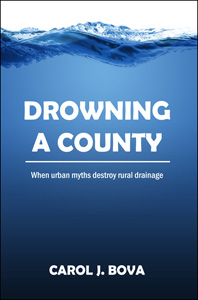 Drowning a County: When Urban Myths Destroy Rural Drainage links myths created by the Virginia Department of Transportation with Mathews County highway drainage failures. The flooding of private property and timber crops has lowered values. Roads are being damaged, and the health of residents and of the Chesapeake Bay are endangered. Budget constraints decades ago reduced ditch maintenance, and VDOT-created myths reduced it further. Working from an urban stormwater management perspective, VDOT officials act without an understanding of the rural watersheds inside the Chesapeake Bay Impact Crater, ignoring their own maintenance manuals.
Drowning a County: When Urban Myths Destroy Rural Drainage links myths created by the Virginia Department of Transportation with Mathews County highway drainage failures. The flooding of private property and timber crops has lowered values. Roads are being damaged, and the health of residents and of the Chesapeake Bay are endangered. Budget constraints decades ago reduced ditch maintenance, and VDOT-created myths reduced it further. Working from an urban stormwater management perspective, VDOT officials act without an understanding of the rural watersheds inside the Chesapeake Bay Impact Crater, ignoring their own maintenance manuals.
Drowning a County reveals the origin of the VDOT-myths and offers facts about drainage, sea level rise and elevation in the county. It counters incorrect planning district reports with details from the Virginia Institute of Marine Science, the U.S. Geological Survey, the National Oceanic and Atmospheric Administration, and other reliable sources. Drowning a County shows how flooded ditches increase the risk of mosquito-borne disease and toxic cyanobacteria, and includes still-valid recommendations from a 1960 U.S. Army Corps of Engineers report and a County-sponsored 1980 drainage study.
Mathews County, a rural Chesapeake Bay peninsula with the same population as in 1910, has preserved much of its pre-development hydrology. Its open network of grass-lined roadside ditches used to offer an efficient system of biofiltration and transport of fresh rainfall. This source of adequate sediment through outfall ditches sustained the County’s extensive tidal marshes and brought oxygenated water to the county’s creeks, rivers and bays. Restoring the ditches of Mathews County can help heal the Chesapeake Bay, and Drowning a County shows what’s needed.








